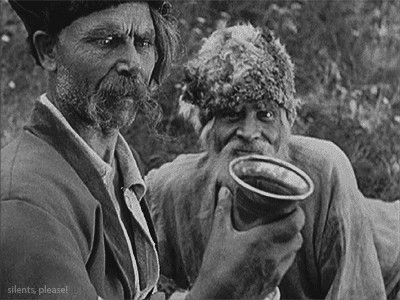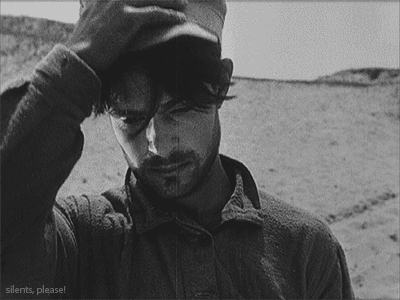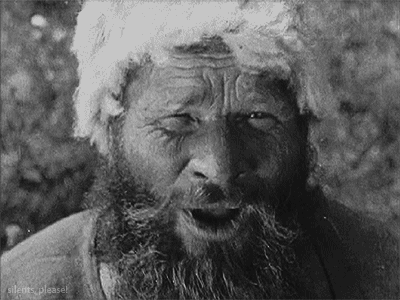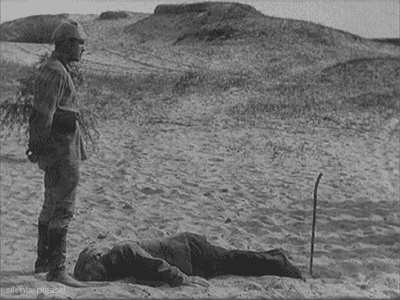Earlier this year, I managed to get hold of the DVD boxset Ukrainian Re-Vision (Укрїнське Німе), published by the State Film Agency of Ukraine in collaboration with the Oleksandr Dovzhenko Film Centre in Kyiv. It’s a wonderful publication: six restored films on DVD, accompanied by a thick text with a lot of historical and biographic information for each film, in both Ukrainian and English. The centrepiece of the boxset is Dovzhenko’s 1927 film Звенигора (Zvenyhora; usually known by its Russian transliteration, Zvenigora); almost a third of the pages of the book are devoted to this film. Though not his first work, this was the film that really launched Dovzhenko’s reputation. Its mythic scope, cyclical view of history, and use of symbolism make it an extremely unique film.
An abstract and mythic sweep
The plot, or at least the general concept, can best be described by Dovzhenko himself:
What would a filmgoer say to me if I rolled a whole two-thousand metres of film—encompassing an entire millennium—past his eyes? Without any intrigues, or love stories, or glimpses of Asta Nielsen or Malynovska?
Or my millennial, primeval, charming, and yet slightly cunning grandpa?
Or 17th century Haidamaky, those awful horsemen, and the senseless slaughter of 1914? And a glorious string of civil war battles from our Great Revolution?
An ambitious project of representing a huge span of Ukrainian history. As is common in many of the best-remembered Soviet films of this period, people in Zvenyhora are archetypes rather than fully-fledged characters. The central figure drawing the film together is that of the grandfather, who recurs throughout the different sections of the film.
Side note: according to the dates given in the book, Nademsky was 35 at the time of Zvenyhora, which seems bizarre to me. Yet it seems not a mistake—his birthdate is given as 1892 on several pages of the Ukrainian Re-Vision book and also in online sources.
Because of the elliptical nature of the film, it is almost impossible to describe Zvenyhora’s narrative; indeed I’m not sure that I have grasped all of the events that take place. One of the most evocative scenes occurs early in the film, when the grandfather encounters a group of bandits (I am not 100% sure, but I think they are Haidamaky). He tells them that the Poles are lurking around Zvenyhora, sacred place: “they dig holes, search cellars: to steal our Ukrainian treasures is what they want.”
The old man and the bandit leader see a treasure chest resting in a hollowed-out tree stump; when they rush to it, it disappears. A goblet is resting on the ground; the bandit seizes it, and it turns to a broken bottle.
After picking off some of the Poles and scaring the rest away, the old man and the bandit leader happen upon a door in the ground:
The monk strides towards the grandfather as he backs away in fear.
The monk’s relationship to the place of Zvenyhora is emphasized by this wonderful double-exposure shot:
The bandits rush him, but are compelled to stop when the monk raises his hand in halt; he throws down his hand and disappears, smoke billowing from the open door from which he emerged, and the bandits are instantly smoten to the ground. In some mysterious way, the monk is the guardian of Zvenyhora.
As far as I can tell, this role was the only film credit for the actor, L. Barné. But I suppose that when you have a role like this on your résumé, you don’t need to work again.
Later in the film, the grandfather relates the story of Roksana, who warns her people of an imminent attack on their settlement by Varangian (Viking) warriors. She rallies her people:
Yet ultimately, she ends up as the prize of a Varangian leader.
The treasure and curse of Zvenyhora is implied to derive from this past event; both this and the monk scene operate at a curious place of both the mythic and the literal level.
Soviet ideology and Ukrainian nationalism
In the present-day manifestation of the story, the grandfather has two sons: Pavlo, a traditionalist and member of the Ukrainian People’s Republic (UNR) Army; and Tymish (above), a committed Bolshevik. This sets up a predictable opposition through which Soviet ideology is glorified. In Zvenyhora, Dovzhenko’s intention seems to have been to repurpose Ukrainian culture and myth towards current Soviet ideals: as the accompanying book says, “Dovzhenko was concerned with [the] legitimization of Ukrainian history through ideology”. Dovzhenko declared this a “Bolshevik film”, and what I have read suggests that he truly believed in the Soviet project. Yet, despite the pro-Bolshevik thrust of the subplots involving the two sons and the “train of progress” (as a friend once described it), this teleological message is undercut by the focus of other sections of Zvenyhora. Of course, I may simply have misinterpreted the nature of certain allegorical elements of the film. However, judging by the excerpts printed in the Ukrainian Re-Vision book, many commentators definitely saw it as a uniquely Ukrainian film and an affirmation of Ukrainian culture; Zvenyhora was received with enthusiasm by the Ukrainian intelligentsia.
These mixed messages were perceived by the Bolsheviks, and the film was quickly withdrawn from circulation. Zvenyhora was however received rapturously by Sergei Eisenstein and Vsevolod Pudovkin. Eisenstein’s description of his first viewing of it is dramatic:
“I’m begging you, come!” the Moscow VUFKU rep is repeating over and over into the phone. “I’m begging. Come and look at this thing they’ve sent us. Nobody can understand a thing. It’s called Zvenyhora.”
We go into the Mirrored Hall where there will be a public screening of this incomprehensible film. “Is it good or bad? Break it down for me”, the VUFKU representative asks. […]
The screening is finished. People stood, not speaking. But it’s in the air already: there’s a new name in film among us. Lord of his own clan. Peer of his own genre. Master of his own identity.
And yet our master. Ours.
Deeply rooted in the best traditions of our Soviet efforts. A master who won’t be going ‘cap in hand’ to the West.
And when the lights came up we all had the sense that we had been present at a defining moment in cinematic history. Before us was a man who had opened a new realm of motion picture. […]
Thus Dovzhenko was ordained as a film director. For just a moment Diogenes’ lantern dimmed and there before us stood a man. An honest, new, mature master of cinema. And an authentic, self-defined direction within Soviet cinematography.
Visual power
Credit is also due to the cinematographer, Borys Zavelev, who photographed the film exquisitely; go to any random scene in this film and it is sure to be strikingly composed. Zavelev was an experienced cinematographer who honed his craft in the pre-Revolutionary era; he collaborated extensively with Yevgeni Bauer, one of my favourite directors.
Dovzhenko was not so keen on montage as some of the other Soviet directors, yet he could employ montage techniques to great effect. Take this sequence of shots, showing the bandits’ reaction to the approaching monk:
What a great eye for faces Dovzhenko and Zavelev have.
There are also skilful (if heavy-handed) transition shots such as this:
Here it seems appropriate to quote Eisenstein again:
Dovzhenko is like a gunshot to the face. […] It was raw luck that Dovzhenko picked up a camera instead of an axe or a machine gun. His films open fire; they attack without hesitation.
Musical accompaniment
Zvenyhora is scored on this DVD release by FUTUREthno, a Polish-Ukrainian ensemble. Very appropriate collaboration considering the content of the film! Judging from the score, FUTUREthno are big fans of jazz and, in particular, early-90s electronica. I really like trip-hop myself, but I have to say that this score didn’t really work for me. I felt it worked against the film rather than with it, in parts it came off as a bad DJ Spooky homage, and I was dubious about the 90s-style scratching … something more droney would have been preferable for me. I loved the contemporary scores I heard with the Ukrainian films presented at Pordenone last year, but this wasn’t my style.
In summary
Zvenyhora is not necessarily an easy film to watch, but it certainly lives up to its billing as a кінопоема (kinopoem). It’s a truly avant-garde work that has a lot to offer and I find new things to see in it each time I watch it.
— — —
Звенигора. Dir. Oleksandr Dovzhenko. VUFKU, 1927.











